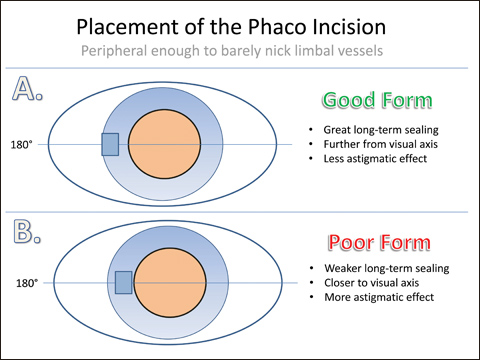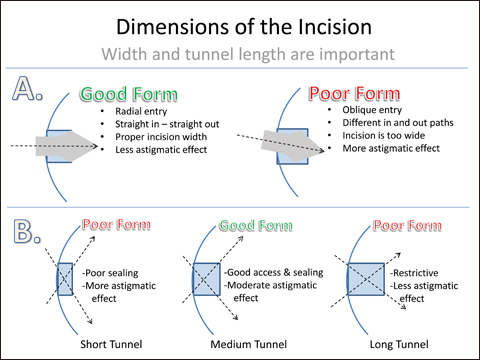Three rules for corneal phaco incisions
A poorly constructed corneal incision could put the patient at a higher risk for complications.
Over the last two decades, cataract surgery has evolved from scleral incisions to corneal incisions, from retrobulbar anesthesia to topical anesthesia, and from rigid IOLs to injectable IOLs. Currently, most surgeons use a corneal incision during cataract surgery because it allows less anesthesia, faster recovery, enhanced access to the anterior chamber and excellent visual outcomes. Residents now start learning cataract surgery with corneal incisions and then learn scleral tunnels later in their training. But be warned that a poorly constructed corneal incision can start a cascade of problems during cataract surgery and could put the patient at a higher risk for complications. I have developed three rules of corneal incisions to help young surgeons learn this critical step of cataract surgery.
Rule 1: Stay peripheral
The best corneal phaco incisions are the ones that barely nick the limbal blood vessels. This is because they are peripheral, far from the visual axis, and produce less astigmatic effect. In addition, the vascular nature allows for more secure and better long-term sealing. A completely avascular corneal incision only heals to a small fraction of its original strength and can be opened even years later with relatively blunt instruments. A corneal incision that nicks the limbal blood vessels will seal securely and return to a high level of strength. This type of incision cannot easily be reopened and will have to be recut in the rare chance that another procedure is warranted in the future.
Placing the incision at the temporal position is more advantageous than placing it superiorly (Figure 1). This is because the temporal limbus is farther from the visual axis than the superior limbus, and thus the temporal incision will induce less astigmatism. In addition, most cataract patients are elderly and have against-the-rule astigmatism, which actually benefits from the placement of incisions at the 180° temporal meridian. When in doubt, a near-clear incision is certainly better than a truly clear corneal incision. If making the incision with a femtosecond laser, care should be taken to align the interface accurately. In most situations, a vascular, near-clear incision is better than an avascular, truly clear corneal incision.
Rule 2: Make the incision symmetric
The corneal phaco incision can be single plane, dual plane or even triple plane, but for all of these variations, the key principle is to keep the incision symmetric. The roof of the incision and the floor of the incision should be approximately equal in thickness. This allows for a more stable incision during surgery and more secure healing after surgery. When looking at the incision under the surgical microscope or the slit lamp microscope, it should have a rectangular or square configuration. If the incision’s entrance through Descemet’s membrane has a chevron appearance, then the floor is likely too thick while the roof is quite thin (Figure 2).

Images: Devgan U


The older teaching of “dimpling down” to enter the anterior chamber tends to produce these chevron-shaped incisions, which are unbalanced and prone to poor sealing. Avoid this mistake by altering the angle of approach of the keratome blade so that the roof and floor are symmetric. In addition, this angle of approach will allow you to tailor the length of the incision to fit your needs.
Rule 3: Keep the incision architecture consistent
The incision plays an important role during phacoemulsification surgery by stabilizing the fluidics in the anterior segment as well as allowing access to the cataract material. The incision width is matched to the phaco tip, irrigation/aspiration tip and lens injector. For most surgeons, this means an incision of between 2.4 mm and 2.8 mm in width, although this can be even smaller for certain IOLs and larger for others. The keratome blades that we use are precision made to be the desired width, and they will perform well as long as the surgeon makes the incision radial and avoids an oblique entry. This oblique entry with different in and out paths will make the incision wider than desired, and this will lead to fluid leakage during cataract surgery, causing an unstable anterior chamber and greater risk for iatrogenic damage to the posterior capsule.
The incision should also be of a precise tunnel length. Too short of a tunnel will provide easy access to the anterior chamber, but it will induce more astigmatism and seal less effectively. The ability to seal at the end of surgery is partially determined by the surface area of the roof and floor of the incision. Shorter tunnels have less area for sealing compared with longer tunnels. But be warned that too long of a tunnel may seal well but it can be restrictive and lead to oar-locking of the instruments, making surgery more difficult.
The ideal incision tunnel length is typically between 2 mm and 2.5 mm measured from the entrance through the corneal epithelium until the piercing of Descemet’s membrane (Figure 3). This type of incision should seal well with only mild hydration required. If a corneal phaco incision does not seal adequately with mild stromal hydration, a suture should be considered to ensure a watertight closure.
The corneal incision is one of the most critical steps in cataract surgery. With these three rules in mind, surgeons should be able to create a balanced, well-sealing incision with minimal astigmatic effect.
- For more information:
- Uday Devgan, MD, is in private practice at Devgan Eye Surgery, Chief of Ophthalmology at Olive View UCLA Medical Center and Clinical Professor of Ophthalmology at the Jules Stein Eye Institute, UCLA School of Medicine. He can be reached at 11600 Wilshire Blvd. #200, Los Angeles, CA 90025; email: devgan@gmail.com; website: www.DevganEye.com.
Disclosure: Devgan reports no relevant financial disclosures.
